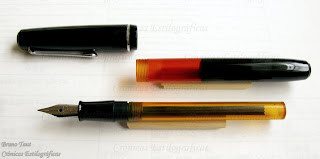The differences are indeed minor, as we can check on the following pictures. The first example is a pair of pens made of black urushi. There are some small differences on the dimensions but, the main one lies on the nib. The original Ban-ei’s nib is signed by Kabutogi Ginjirô’s (兜木銀次郎) initials (GK). This was, in actual terms, the only reference to the authorship in the whole pen.

On top on both pictures, the Danitrio-commissioned pen. On bottom, the previous, unsigned (save for the nib) unit. The most obvious difference is the engraving on the cap band of the later model.
The second pair is decorated with a subtle urushi-e pattern. In this case, there is a very obvious difference—the cap ring present on the Danitrio-commissioned unit where the brand Ban-ei and the serial number were engraved. And as was the case with the black urushi pens, only the old Ban-ei nib is engraved with the initials of the nibmeister.

The pre-Danitrio pen does not have any band on the cap, and its nib has a heart-shaped breathing hole. This nib is also engraved with the initials GK of Kabutogi Ginjirô just below the JIS mark.
As it is known, Danitrio-era Ban-ei pens were limited editions of less than 500 units. However, the old pens, made in the seventies and eighties, are in my experience harder to find in the market. These older pens are also known as Tsuchida pens, after Tsuchida Shuichi (土田修一), who was in charge of the final assembly of the pen.
My thanks to Mr. Shimizu.
Platinum sterling silver pen, 14 K nib – Platinum Brown
Bruno Taut
Madrid, December 25th, 2012
etiquetas: Ban-ei, Danitrio, nibmeister Kabotogi Ginjirô, urushi, urushi-e
Bruno Taut
Madrid, December 25th, 2012
etiquetas: Ban-ei, Danitrio, nibmeister Kabotogi Ginjirô, urushi, urushi-e


















































